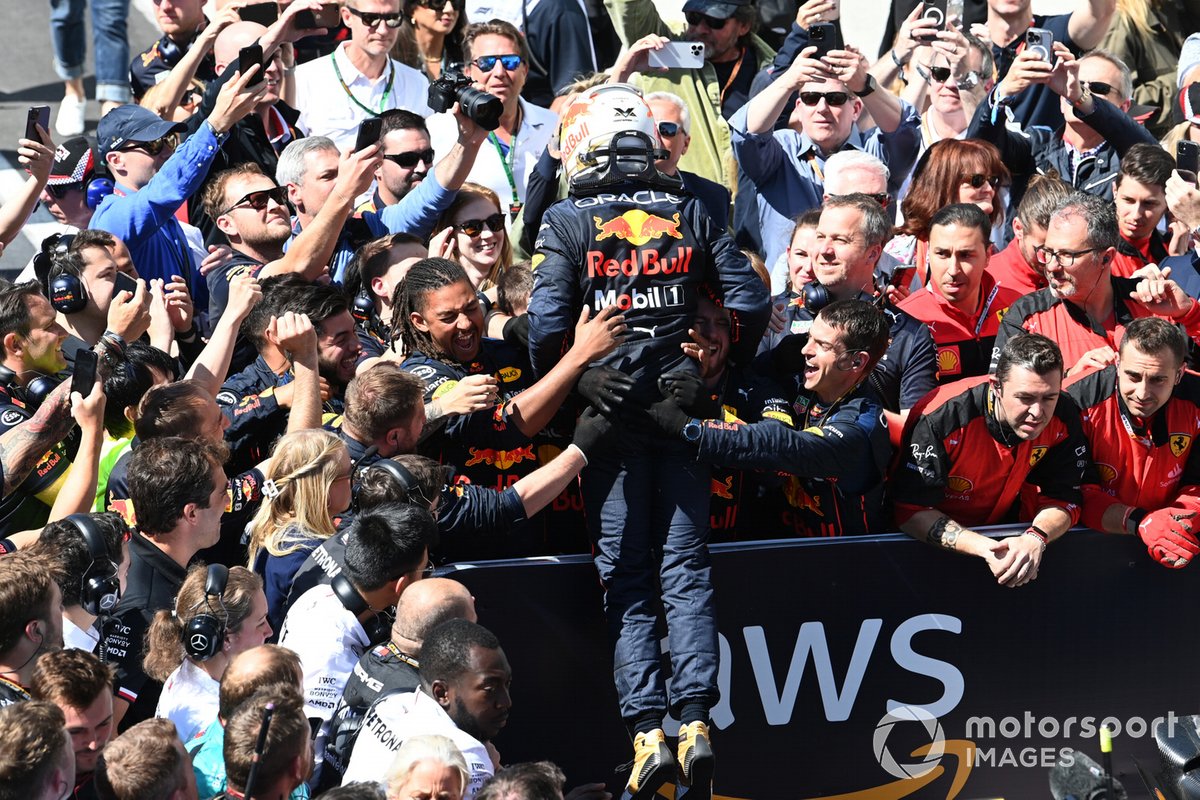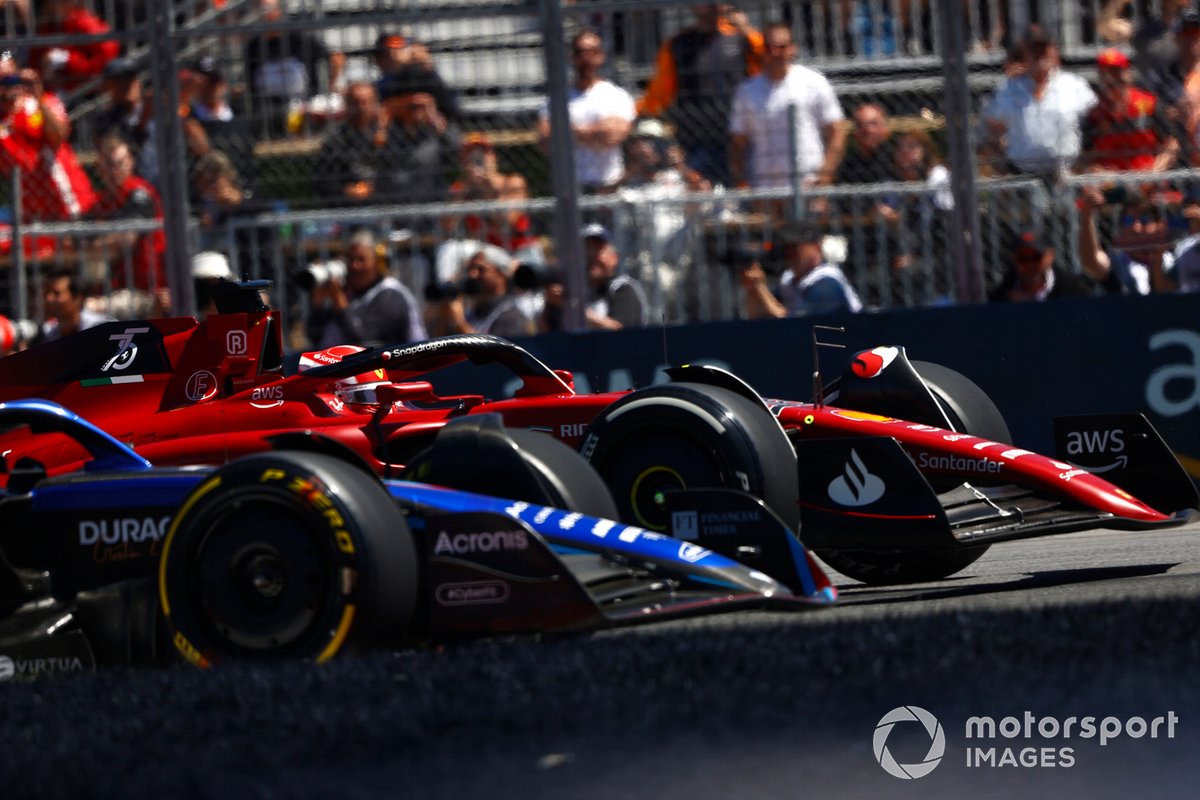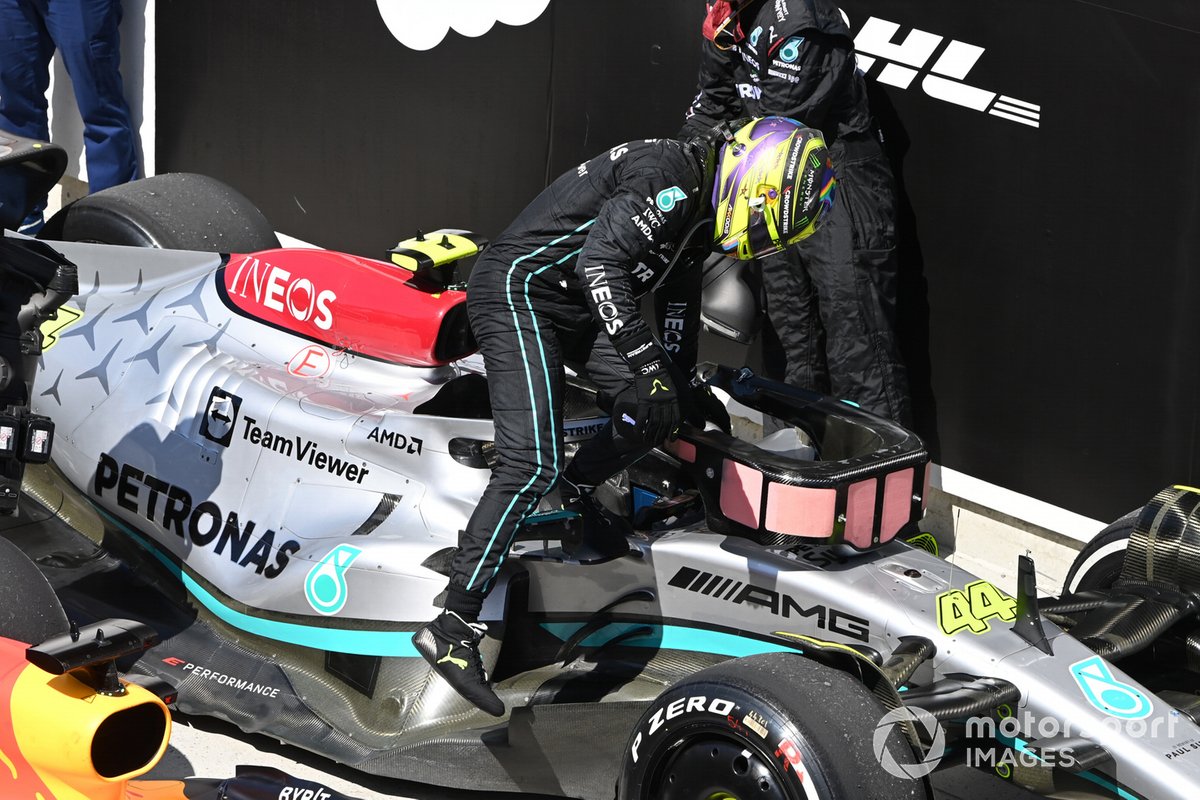While a safety car paved the way for a late-race crescendo in the Canadian Grand Prix last weekend, Max Verstappen again took charge to claim his sixth victory of the 2022 Formula 1 season and further strengthen his title defence.
Currently operating in white-hot form, Verstappen now sits some 46 points clear at the top of the standings over Red Bull team-mate Sergio Perez, while Ferrari rival Charles Leclerc is a further three points in arrears.
That healthy championship advantage has been boosted by the recent Ferrari unreliability implosion.
Leclerc endured the latest consequences of the Scuderia’s fragility at Montreal as he took on new power unit components to be sent marching towards the back of the grid.
That meant it was left mainly to Carlos Sainz - still in pursuit of his first top-flight triumph - to take the challenge to Verstappen. Despite the rain in qualifying having set up a tantalising front row, with Fernando Alonso alongside the RB18 for the sprint into Turn 1, it was his fellow Spaniard who welded himself within DRS range of Verstappen.
Sainz did fall short but proved he can take the fight to Verstappen after his underwhelming adaption to ground-effect. Meanwhile, Mercedes was buoyed Barcelona-style after Lewis Hamilton completed the podium by finding an affinity with the troublesome W13. Leclerc then stemmed the bleeding of points to Verstappen by recovering to fifth behind George Russell, despite his own complaints in the cockpit.
With those headlines and plenty more subplots generated from the 70 laps of the Circuit Gilles Villeneuve, here are 10 things we learned from the Canada weekend.

1. Virtuoso victory validates Verstappen’s versatility
To witness Max Verstappen take control of a weekend like he did in Canada is not to learn anything new. He’s stitched together perfect days before. But his most recent performance encapsulated and double underlined the breadth of his abilities.
That was vividly on show during a slippery qualifying. With five minutes of Q2 to play, Carlos Sainz turned in a 1m29.153s to bolt to the top of the times. The next person over the line, to mitigate track evolution, was Verstappen. He punched in a 1m27.764s. That cavernous 1.389s advantage and pole position reflected his excellence in the treacherous conditions.
He then showed a different way to win the following day. In Saudi Arabia he outwitted Leclerc for DRS in the climax to an enthralling battle. At Imola, he was undoing the damage of the RB18’s early unreliability and his path to the top step of the podium in Spain and Azerbaijan were certainly eased by Ferrari’s own engine woes. Adding a string to his bow was the way he led from the front in Canada.
He immediately put Fernando Alonso in the shade. He then worked around an ailing radio, inferior top speed, and a medium compound tyre pace deficit relative to Sainz. When the safety car artificially brought Sainz back into play after his aborted one-stop strategy, it crafted some Miami-style late-race tension, but Verstappen never looked like letting the win slip a la Sebastian Vettel in 2011 or 2019.
Verstappen was quick to play down his march to a possible second title, naturally pointing out the season is only one-third done. But when Ferrari has delivered moments that might be looked back on as ‘points the championship was lost’, what Verstappen did in Canada on only his 150th GP start might be remembered as a moment ‘the championship was won’.

2. Ferrari appears to have rectified at least one of its flaws that cost a win
For the second race in a row, Christian Horner has pitched a hypothetical. In Azerbaijan, he was confident Max Verstappen had the pace advantage on fresher tyres to pass Charles Leclerc on merit for victory prior to his engine blowing up. Similarly, the Red Bull boss reckons that had a safety car not intervened to instead leave Carlos Sainz running in front on a one-stop strategy, Verstappen again had enough to come from behind and win.
The reason the Ferrari drivers have been in those advantageous positions, at least in terms of track position, for the past two races has been on account of cat-like reactions to virtual safety cars (in Baku, Leclerc darted immediately to stop when Sainz’s hydraulics failure neutralised the race) and full-blown safety cars (Sainz pitting in response to Yuki Tsunoda dropping it at the pit exit).
In both cases, the other Ferrari wasn’t in contention for victory leaving the pitwall without the luxury of splitting strategies between drivers to cover off threats. Twice it has had to gamble and seize it chance. While the Scuderia didn’t win in both scenarios, the calls from both drivers and pitwall have been much more fleet of foot rather than the cumbersome reactions in Monaco that lost a 1-2 before even a third of the race had run.
The chances of landing the spoils in Baku were hurt by the F1-75’s pace deficit to the Red Bull, had events played out in their entirety. Those chances were then wiped out by the engine failure for Leclerc. Matters were closer in Montreal. Sainz had the pace on Verstappen for the final hard-tyre sprint to the flag as he turned in fastest laps and had the advantage through the speed traps. But the red car’s struggles out of the Turn 10 hairpin, which Leclerc also endured, helped Verstappen keep far enough ahead to survive the late DRS threat.
While Sainz missed out on the win, had Ferrari ignored the changing picture and stuck religiously to its one-stop plan, the Spaniard would likely have been out of contention far earlier as Verstappen chewed through a 9.5s gap on 23-lap newer tyres with 24 laps to run.

3. Sainz should be taking the fight to Red Bull more often
Carlos Sainz reckoned he felt more at home in the subpar 2021 Ferrari than he has in the more competitive ground-effect 2022 challenger. That, he says, has explained the pace gap to team-mate Charles Leclerc - with his Australia and Imola crashes not helping matters by any stretch.
But Sainz notably stepped up to take the fight to Max Verstappen at Montreal, with Charles Leclerc largely out of the picture thanks to grid penalties.
While Sainz pushed too hard on his final Q3 lap to haemorrhage time in the final chicane and concede a front-row grid slot to Fernando Alonso, elsewhere he had the pace and was in the closing stages of the grand prix the fastest driver on track. A point for fastest lap is proof of that. And although a win went begging again, he made it a close-run affair with Verstappen, having capitalised on the safety car to pit for hards.
With that stronger performance, Sainz has now made a rod for his own back. After the reliability turmoil, Ferrari has a 76-point gap to close to Red Bull in the constructors’ championship race. What’s more, although Monaco so far looks like a peak rather than the par for Sergio Perez, the Mexican is nevertheless able to get closer to Verstappen’s benchmark this season.
As such, if Ferrari is wanting to cut the gap to Red Bull in the most efficient way, it needs Sainz to form one half of a two-pronged attack. Leclerc has so far been doing the lion’s share, but Sainz has now shown he can also do the heavy lifting also. He must make his Montreal performance the norm.

4. Leclerc can limit the damage when needs must
Given the outstanding run of form Max Verstappen is currently enjoying, Ferrari quite simply needs Charles Leclerc to be winning races to close the points gap and tee up the thrilling title showdown we all want to see. And for Leclerc to be winning races, he plainly needs Ferrari to banish its unreliability demons. By any measure, fifth place isn’t enough for the Monegasque to get the job done should his key rival keep wrapping up the wins.
But his recovery from 19th on the grid to bank 10 points in a race that wasn’t jumbled up by inclement weather was a sound enough return as Leclerc fought back from a back of the grid penalty for a fresh engine. It stemmed the loss on a day when Leclerc was hampered by the DRS train and a difficult differential that was costing him dearly out of Turn 10 for the crucial drag into the final chicane.
While in the circumstances it was an effective display of damage limitation, the unfortunate reality is that Leclerc will likely need to deliver a similar performance as Ferrari continues to pay the consequences of its Monaco and Baku engine blow ups. With the power unit that let go in Azerbaijan found by Ferrari to be “beyond repair”, Leclerc is still on course to exceed the maximum permitted three turbochargers before the hybrid elements and internal combustion plus any further gremlins are considered.
Although Ferrari picked passing-friendly Canada as a venue to take the hit knowing that all was not lost, the team will likely have to make a similar strategy call to leave Leclerc to fight through the cut and thrust of the pack purely to hang onto the coattails of Verstappen.

5. Hamilton’s season has been hurt by his own experience
The quotes from Canada offered the best insight yet as to why George Russell has arrived at Mercedes and seemingly had the measure of seven-time champion team-mate Lewis Hamilton at every turn. Ill-timed safety cars have played their part in why Russell has ended seven races on top. But there’s another major factor. Namely, as Mercedes has struggled to unlock its W13 creation, it has been the 37-year-old who has made do with experimental, pace-sapping set-ups in a bid to learn what makes the car tick.
Hamilton was “ecstatic” as he bagged a podium. Tellingly, compared to his downbeat tones in Spain and Azerbaijan, he was much chattier and more optimistic over team radio in the race. This was not a driver who wanted to retire early after contact with Kevin Magnussen, but one who instead had his sights firmly on a tilt for fastest lap while keeping a keen eye on the progress being made by Charles Leclerc.
The weekend hadn’t started off well. Hamilton abandoned the updated floor for FP2 and ran an experimental set-up he called a “disaster”. But a switch to run in trim more similar to Russell’s car plus background work at the Mercedes factory and in the simulator helped turn things around.

6. Although any Mercedes optimism might need to be checked again
But we have been here before with Mercedes. Toto Wolff reckoned the gap to Ferrari and Red Bull had been halved at Barcelona before the definite backwards steps of Monaco and Azerbaijan, which left George Russell and Lewis Hamilton suffering with an unwelcome blend of physical and mental pain.
A 3-4 result was a marked step forward last weekend, even if that likely becomes a 5-6 should Charles Leclerc and Sergio Perez have factored as the front as might normally be expected. Furthermore, Hamilton still crossed the line 7s down on race winner Max Verstappen, a gap which was flattered by the late-race safety car that bunched up the field.
The word is Mercedes has finally “solved” its porpoising issue, but it is still afflicted by another kind of bouncing as the car runs low and stiff to pound into the asphalt. The onboard footage picks this up clearly as the floor scratches over the tarmac.
And lingering on, there is fundamental a lack of performance from the car. Take the race’s crescendo.
Hamilton was shod in hard tyres that were one-lap younger than those worn by Verstappen for the post-safety car sprint to the flag. And as Verstappen fought off the advances of Carlos Sainz, Hamilton was consistently seven-tenths adrift per lap. As per Barcelona, claims that this was a display of pace that on another day would be capable of winning a race appear somewhat wide of the mark.

7. ‘Old dog’ Alonso is still up to his old tricks
A remarkable stat doing the rounds was that Fernando Alonso’s romp to the second-fastest time in qualifying marked his first front-row start of the hybrid era. The raucous reaction from the Montreal grandstand on the main straight as the two-time champion exited the car after his sterling one-lap effort said everything about his enduring popularity, even if the results of the past nine years haven’t been there.
It was a shame that after his vintage effort in the slippery conditions that Alonso offered no challenge to Verstappen into Turn 1 and then gradually faded with an engine air leak that particularly restricted his final 20 laps.
Although that didn’t deny a textbook Alonso show. His usual hyperbole (think “GP2 engine”) was up to scratch when he claimed over team radio to be “100 times” faster than team-mate Esteban Ocon. And his last-lap weaving in front of Valtteri Bottas copped the 5s penalty that dropped him to ninth but was the latest case of Alonso pushing the boundaries to test the word of the stewards.

8. McLaren’s backwards step is real and sizeable
A lack of mileage in testing and brake duct issues were followed by uninspiring McLaren performances in the first two rounds of the campaign. Then, a 5-6 in Australia - Lando Norris heading Daniel Ricciardo - was attributed to the track particularly suiting the MCL36, a car with good balance but a lack of overall pace to maintain the upward Woking trend of the past five years.
Similarly, a podium for Norris at Imola was seen as opportunistic and again belied where the team sits in the 2022 pecking order. But then the recent run of points-scoring results up to and including Azerbaijan seemed a more stable foundation, a greater cause for optimism.
Canada (11th for Ricciardo and 15th for Norris following a 5s penalty for pitlane speeding to compound a botched double-stack pitstop blunder) promptly undid the good feeling. As per Norris, the car was “not anywhere [near] where we want it” and that “a day like today is probably a good thing” to show the team is “a long way off”.
“We have to keep working very hard to keep trying a lot of different things Maybe at times, things look great. But it's never really like genuine pace, you know. We’re a little bit there on luck sometimes. A day like today when it's just more simple and you don't have luck on your side, it shows where we're actually at.”

9. Porpoising’s immediate threat was too much to ignore…
Lewis Hamilton reckoned the bouncing experienced at the wheel of his Mercedes W13, aside from his back pain, had led to more headaches as a result of 10G impacts. George Russell, meanwhile, revealed that the movements in Baku had left him unable to see his pit board. With the FIA fearing that even these effects might still only be the thin end of the wedge, it has intervened on safety grounds to hopefully prevent the oscillations triggering a major shunt.
On the eve of the Canadian Grand Prix, the governing body announced it would be observing events at Montreal and collecting data ahead of the trip to Silverstone, where it will take action against cars which exceed permitted levels of vertical acceleration. Those caught fouling by being too aggressive with set-up, and pushing it into an area where its car is porpoising, could be forced to make changes to dial it out. That could mean moving the car out of an ideal set-up window - and that could mean sacrificing lap time to ensure compliance with the rules and guaranteeing that drivers are not suffering the ill-effects of porpoising.
Although measures to prevent porpoising last year were suggested, they were passed on by teams. But now acting on the grounds of safety, the FIA has circumnavigated the need for consensus and approval from the teams and stepped in.

10. … and you can’t ignore the paddock’s toxicity either
“Manipulate…play political games…disingenuous…Chinese whispers…just pitiful”. If there was any danger of Formula 1 enjoying a time of relative peace following the 2021 Abu Dhabi title decider fallout and the missile attack in Saudi Arabia, Toto Wolff’s words proved that the new season will still enjoy a controversial edge as team bosses create a fuss over the FIA's actions.
This too comes back to the business of porpoising, with Red Bull aggrieved at a mid-season rule that - as per Christian Horner's reading - might help rather than hinder Mercedes should any set-up changes be imposed. The Silver Arrows also abandoned a second floor stay for Canada with murmurs that it could be protested.
Given this is only the first reaction to the FIA intervention during a weekend when the governing body was observing rather than declaring technical directives, expect the name-calling and infighting to continue. Oh joy.






